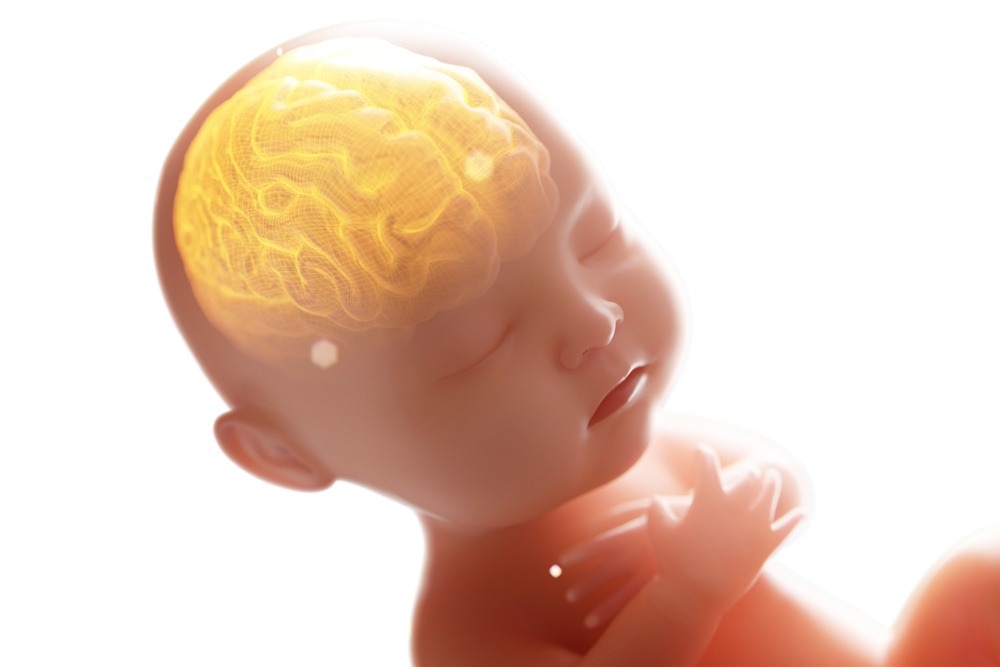In a recent Environmental Research journal study, scientists report that gestational exposure to low levels of bisphenol A (BPA) may induce structural alterations in some fetal brain regions.

Study: The effects of prenatal bisphenol A exposure on brain volume of children and young mice. Image Credit: Connect world / Shutterstock.com
Background
BPA is a synthetic chemical that is widely used in plastic and resin manufacturing industries. Individuals working in these sectors are often ubiquitously exposed to BPA, which is known to disrupt many physiological functions, such as those involving the endocrine system and metabolism. Moreover, several studies have linked long-term BPA exposure with a higher risk of coronary artery disease and polycystic ovarian syndrome.
In North America, more than 80% of the population exhibit detectable levels of urinary BPA. High BPA exposure during pregnancy can lead to transplacental transfer of the chemical and subsequent disruption of fetal development. In this context, increased gestational exposure to BPA has been shown to increase the risk of neurodevelopmental disorders, neuropsychiatric disorders, as well as cognitive and behavioral disorders.
In the current study, scientists investigate whether gestational BPA exposure alters the brain volume in children. Using animal models, the researchers also determine the mechanisms responsible for BPA-induced alterations in brain structural development.
Study design
The current study included women and children who were enrolled in the ongoing Alberta Pregnancy Outcomes and Nutrition study. Women were enrolled during pregnancy, and their children were followed up until they reached eight years of age.
Urine samples were collected from women during the second trimester of pregnancy to measure urinary BPA levels. Children who had gestational BPA estimates were subjected to magnetic resonance imaging (MRI) analysis of the brain.
For the in vivo experiments, pregnant mice were exposed to a human-equivalent level of BPA. The impacts of this exposure were assessed in mice offspring through brain MRI.
Impact of gestational BPA exposure on brain volume in children
Brain MRI findings revealed only small to medium effects of gestational BPA exposure in most of the tested brain volumes, except for three brain regions.
The largest negative association of gestational BPA exposure was observed with the opercular region of the inferior frontal gyrus and superior occipital gyrus. In contrast, the postcentral gyrus showed a positive association with the level of exposure.
Regarding the limbic system, small or minor effects of gestational BPA exposure were observed in the hippocampus, entorhinal area, amygdala, and accumbens area.
Regarding gender-based differences, a mild impact of gestational BPA exposure was observed in the gyrus rectus, putamen, medial frontal cortex, and opercular part of the inferior frontal gyrus in male children.
For females, BPA exposure exerted a mild impact on the superior parietal lobule, planum polare, frontal operculum, medial orbital gyrus, transverse temporal gyrus, and superior frontal gyrus medial segment.
Regarding hemispheric differences, small effects of BPA exposure were observed in the superior occipital gyrus and postcentral gyrus regions of the left hemisphere. Additional effects were observed in the transverse temporal gyrus, opercular part of the inferior frontal gyrus, medial frontal cortex, para-hippocampal gyrus, and frontal pole of the right hemisphere.
Impact of gestational BPA exposure in mice
MRI analysis of mouse brains revealed that gestational BPA exposure significantly alters the volumes of eight brain regions, including the superior olivary complex, bed nucleus of stria terminalis, periaqueductal grey, olfactory tubercle, and posterior commissure exhibited reduced volumes. Comparatively, inferior cerebellar peduncle, entorhinal cortex, and parieto-temporal cortex increased in volume.
Regarding the limbic system, gestational BPA exposure increased the volume of the hippocampus. BPA exposure also altered the volumes of four left hemisphere regions and six right hemisphere regions.
Study significance
The current study confirms that fetal exposure to BPA during pregnancy can have small to medium effects on brain volumes in children.
The study findings suggest that the prefrontal cortex is particularly sensitive to BPA exposure. Since the prefrontal cortex is associated with language processing, gestational exposure to BPA can lead to developmental language deficits in children.
Furthermore, the observed effects on the superior occipital gyrus and superior olivary complex suggest that gestational exposure to BPA can also lead to visual and auditory impairments.
Journal reference:
- Zheng, J., Reynolds, J. E., Long, M., et al. (2022). The effects of prenatal bisphenol A exposure on brain volume of children and young mice. Environmental Research. doi:10.1016/j.envres.2022.114040.